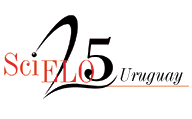An approach to Antonio Ruiz de Montoya´s "Conquista Espiritual" discourse through the study of benevolent images
DOI:
https://doi.org/10.25185/2.8Keywords:
Montoya, assistants, hope, Saint ThomasAbstract
the natural human geography, living together with supernatural creatures, is often narrated as ordinary in the chronicles of towns foundations, evangelization and the defense of the communities from Guayrá, Paraná, Uruguay, and Tape. The Jesuitic missions, strongly separated and delimited from the outside, appear to be, for father Montoya, as the very specific space for interaction between men and God. The heavenly figures will guide Indians to live according to the dogma and will be the priests’ helpers. These figures of «rescue» (among which stands out especially St. Thomas the Apostle) appear in the story as an instrument to liberate the Indians from Evil, forming thus a hopeful message. Our goal is to offer a linguistic and structural approach, together with an hermeneutic reading. The aim is also to reveal the narrative structure of the Jesuit, the actants, the nodal tensions and the isotopies networks, in order to think in the semantic content of the message that shows the state of the art in the very symbolic universe of Ruiz de Montoya.
Downloads
References
Fuente Primaria:
Ruiz de Montoya, Antonio: Conquista Espiritual hecha por los religiosos de la Compañía de Jesús en las Provincias de Paraguay, Paraná, Uruguay y Tape [1639].
Equipo Difusor de Estudios de Historia Iberoamericana, Rosario, 1989.
Estudio preliminar y notas Dr. Ernesto Maeder.
Bibliografía General:
Armani, Antonio: Ciudad de Dios y ciudad del sol. «Estado» jesuita de los guaraníes (1609-1768). Traducción de Marcos Lara, Fondo de Cultura Económica, Méjico, 1988.
Calvi, Edgardo: Las milicias de las doctrinas jesuíticas del Paraguay. Origen, evolución e influencia social y política. En: JORNADAS. Aporte de las Universidades Católicas al Quinto Centenario del descubrimiento y de la evangelización de América. Su misión ante la nueva evangelización. Tomo II. Buenos Aires, septiembre, 1992, pp. 113-123
Lafaye, Jacques: Mesías, cruzadas, utopías. El judeo-cristianismo en las sociedades ibéricas. Traducción de Juan José Utrilla, Fondo de Cultura Económica, Méjico, 1984.
Lévi-Strauss, Claude: Antropología estructural. Mito, sociedad, humanidades. Traducción de Juan Almela, Siglo XXI, Méjico, 1997.
Ramos Gavilán, Alonso: Historia del célebre santuario de Nuestra Señora de Copacabana y sus milagros e invención de la Cruz de Carabuco. Segunda edición según impresión príncipe de 1621, Academia boliviana de la Historia, La
Paz, 1976.
Ricoeur, Paul: Hermenéutica y Estructuralismo. Traducción de Graziella Barravalle y María Teresa La Valle. Megápolis, Buenos Aires, 1975.
Van Dijk, Teun: La ciencia del texto. Traducción de Sibila Hunzinger. Paidós, Barcelona, 1992.
Published
How to Cite
Issue
Section
License
Copyright (c) 2017 Marcela Pezzuto

This work is licensed under a Creative Commons Attribution 4.0 International License.



























